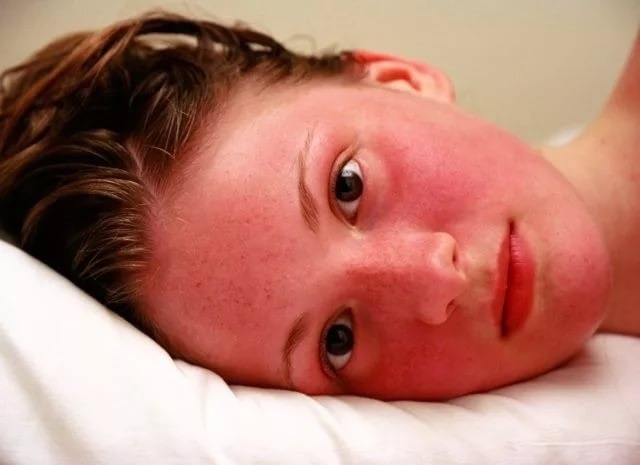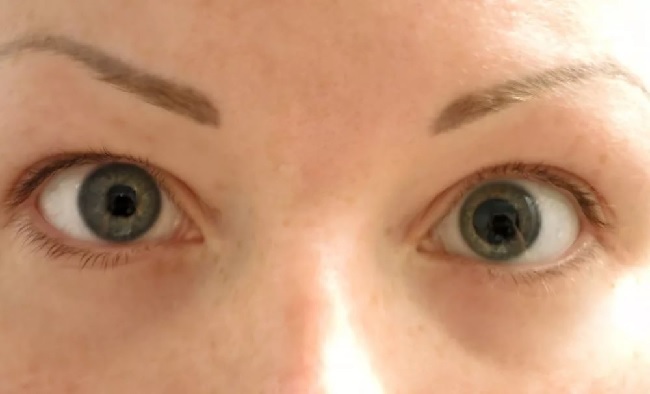EEG of the brain in children: what parents need to know
Content:
- The essence of the
- method Indications for the procedure
- Preparation of the child
- Beginning of the procedure
- Features of the study
- Analysis of the results
Any examinations concerning the determination of the brain state in children cause a storm of emotions in their parents. In fact, most diagnostic methods used in pediatrics are absolutely painless and safe. One of them is encephalography( EEG).
The essence of the method
EEG of the brain in children is a type of study of the activity of the cerebral cortex, which is based on the fixation of electrical potentials. This method is considered the best way to obtain information about brain work in children at any age. The human nervous system consists of billions of cells called neurons. All of them have the ability to create and transmit electrical impulses. The total activity of neurons forms bioelectric activity of the brain. It is recorded and recorded graphically in the EEG.The result is an electroencephalogram. This document with a lot of curved lines informs the doctor about how the processes in the brain of the child are going on: in normal mode or they have undergone pathological changes.
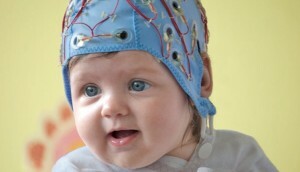
EEG in toddlers
Indications for
procedure Having received a doctor's direction to encephalography and having found out the answer to the question: "What is EEG of the brain?", Mom and dad, of course, begin to fear with fear how and why this procedure is neededTheir child. However, it is recommended not only when you suspect a certain disease, but also for a standard assessment of the baby's brain. Encephalography can be prescribed to a child by a psychiatrist, a neurologist or a neuroscientist. The standard indications for the procedure are as follows:
- convulsions and seizures of cerebral origin;
- brain injury;
- tumors and other brain diseases;
- assessment of the adequacy of development of children of the first year of life;
- frequent headaches, dizziness, unconsciousness;
- sleep disturbances, including sleepwalking;
- irritability, short temper;
- unexplained regular crying;
- unstable blood pressure.
As you can see, this study is assigned with very many problems associated with the work of the nervous system. And all because the EEG of the brain reveals the main violations in its functioning. Encephalography allows not only diagnosing diseases such as cerebral palsy, minimal cerebral dysfunction, encephalopathy, vegetative dystonia syndrome, epilepsy and others, but also to select drugs for their treatment, as well as evaluate the effectiveness of therapy.
In addition, even if the baby does not have serious illnesses, but has difficulties in behavior and development, he is shown EEG.This procedure is able to help the doctor determine the causes and severity of pathologies with a lag in speech and motor development, problems with memory and attention, hyperactivity and so on. EEG is also recommended for school-age children if they are too fatigued or overextended.
Preparing a child
Before you do an EEG of the brain, the baby needs to be prepared. Since the procedure of encephalography involves the installation of electrical sensors on the child's head, it is recommended to wash the hair with baby shampoo on the eve of the day of the examination. Further features of training depend on the age of the offspring.
Infants do EEG only in a state of sleep, as a rule, it happens in the afternoon. That the kid for certain has fallen asleep, at purpose or appointment of time of procedure it is desirable to consider its habitual schedule of a dream and wakefulness. Also, doctors advise to feed the crumb immediately before the session from the bottle. If he is on natural feeding, his mother should express the milk.
For children after the year, encephalography is performed during the waking period. It is very important for the child to behave calmly and clearly follow the doctor's instructions. It is especially difficult to implement this condition with two-three-year olds. So, parents should pay special attention to the psychological preparation of their son or daughter. Here's what psychologists recommend:
- First, with a child it's worth talking about, describing the future survey as a fun and safe game. For example, you can say that he will become an astronaut or a superhero.
- Secondly, it is best to bring toys and books to the clinic that can distract and calm the crumbs. It can be well-known and favorite games or, conversely, new and exciting.
- Third, that the baby is not capricious, it must be fed shortly before the EEG.In addition, you should try to plan the regime of the day so that at the time of the session the child does not want to sleep.
- Fourthly, in some cases during the procedure of crumbs, certain actions are required( eye opening, breathing at a given rate, passing tests).
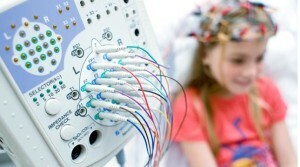
EEG procedure for children
All this makes sense to rehearse at home in a relaxed environment. In addition, since the child will need to wear a special hat, it is advisable to include this moment in the preparation process. It is worth noting that if a child regularly takes any medications, then you can not refuse them before the EEG.You just need to report this to the doctor. Encephalography has no contraindications, but this procedure is not performed if the child has a runny nose and cough. Before the session, the head of the baby should be removed all ornaments, including earrings, and also to dissolve the hair.
Beginning of procedure
Encephalography is performed in a small light and soundproof room equipped with a couch or changing table, as well as a recording device. Before the procedure, the child is put on the head with a special cap. It can look like a fabric helmet with electrodes or a rubber mesh, on which the necessary number of sensors is pinned in the manual mode. With the encephalograph, the sensor electrodes are connected using soft wires. It is worth noting that the biocurrents flowing in the electrodes are very small and can not harm the baby.
In addition, the encephalographic equipment must be grounded. Before applying the sensors, the doctor moistens them with a gel, water or saline solution. This is done to avoid formation between the scalp and the electrode of the air cushion. Sometimes it is required to wipe the skin itself with alcohol to remove the skin fat from it. In addition, the ears of the toddler are worn with clip-electrodes, which do not conduct current.
Features of the study
The order of how the EEG of the brain is done is determined by the age of the child. Children up to a year often lie on the hands of a mother or on a changing table. It is important that the baby sleeps during the procedure. If the child is naughty, the doctor must first calm him down. The encephalography session lasts up to 20 minutes. Its purpose is to register the bioelectrical activity of the crater's brain in a calm state. Older children may be given more advanced research. The child is placed on the couch in a reclining position, the head should not be tilted forward, otherwise there may be distortions in the electroencephalogram. It is also necessary that the small patient be completely relaxed. The standard EEG procedure includes the following steps:
- Recording a "background curve," that is, fixing the activity of the brain at rest.
- Test with opening-closing eyes. It allows you to explore the work of the brain in the transition from a state of rest to activity and back again. At this stage, the child should open and close his eyes at a certain interval at the doctor's command.
- Test with hyperventilation. Through this exercise, you can identify such pathologies as epilepsy in a latent form, inflammation and brain tumors, chronic stress and so on. Hyperventilation implies rare but deep breathing and exhalation, usually a doctor turns this process into a game, suggesting that the baby "blow hot" or "put out the candle".
- A sample with photostimulation. This action is aimed at assessing the adequacy of the child's psychomotor and speech development. Also, photostimulation can diagnose epileptic activity. A sample is carried out using a light bulb that produces bright flashes in a given rhythm, the eyes of the child are closed, but he still sees the flashing and reacts to it.
The duration of a routine procedure does not exceed 30 minutes, but in some cases additional studies are needed. The doctor can apply the effect of sound stimuli, ask the child to squeeze-unclench the fists and conduct psychological tests. Also sometimes photostimulation is performed at higher frequencies, a preliminary dark adaptation, suggesting that the baby is in a darkened room for 40 minutes, or recording readings during the entire period of night sleep.
Analysis of the results of
As a result of the EEG, a document called an electroencephalogram is formed, in which the activity of neurons of different parts of the brain is reflected in the form of curved lines. Currently, the results of the procedure are recorded not only on paper, but also in a computer program, which significantly simplifies the process of analyzing the data. New technologies allow spectral analysis of EEG, scan individual sections, calculate their frequency and amplitude, convert oscillations into diagrams, maps and tables. All this provides the doctor with clear and accurate data, on the basis of which he can establish a diagnosis.
Having received the results of the research, parents should remember that the transcript of the EEG of the brain is the prerogative of the attending physician. The fact is that in encephalography there is no clear concept of age norms, the activity of brain impulses in each child is individual, especially for infants. Therefore, only the doctor can take conclusions, which will take into account not only the result of brain research, but also additional tests, as well as epicrisis of other specialists.
It should be noted that encephalography is an absolutely safe procedure, which can be repeated many times. It is important that the parents keep the EEG results, because at a young age the nervous system only ripens and the characteristics of its activity are very variable. Thanks to the protocols of encephalography at different times, the doctor will be able to monitor the dynamics of the development of the brain and adequately assess the picture of the disease.
The bioelectric activity of neuron cells is a very important indicator characterizing the work of the nervous system. EEG of the brain in children is the only accessible, accurate and safe method of analyzing the work of all brain structures, which can be used for both diagnosis and control of treatment. Therefore, having received a recommendation from the doctor to go through the EEG, parents should calmly take this perspective, properly prepare the baby and support him on the day of the procedure, leaving the rest to qualified specialists.
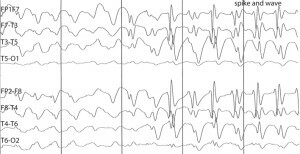
decoding of EEG
write the question in the form below:

